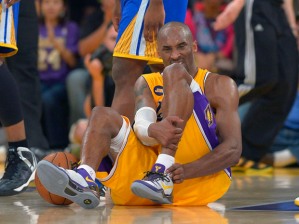Via Twitter @SportsCenter: BREAKING: Lakers say Kobe Bryant is suspected to have torn his left Achilles. Will have MRI tomorrow to confirm.
 Simply stated, this is a big blow to a team that can’t afford to lose players, or games, at this pivotal time of the season. There is no question, losing Bryant for the remainder of the season will have a significant impact on the Los Angeles Lakers. While many speculate whether the playoff run for the Lake Show may be over, many more are wondering whether Kobe’s career will also come to and end. My answer: absolutely not.
Simply stated, this is a big blow to a team that can’t afford to lose players, or games, at this pivotal time of the season. There is no question, losing Bryant for the remainder of the season will have a significant impact on the Los Angeles Lakers. While many speculate whether the playoff run for the Lake Show may be over, many more are wondering whether Kobe’s career will also come to and end. My answer: absolutely not.
Achilles tendon ruptures are not uncommon, with a reported annual incidence of 18 per 100,000 (common medically speaking). Multiple contributing factors are associated with this injury, including poor tendon vascularity, pre-existing degenerative changes, a poorly conditioned musculo-tendinous unit, age, and changes in training patterns.¹ While many news sources and anchors have attempted to place blame on the coaching staff for not providing Bryant adequate rest, the bottom line is that fatigue, due to overuse, was not the sole reason for his injury. It was likely a combination of the aforementioned conditions and a little bit of bad luck. It was a “perfect storm” with an imperfect ending.
Kobe will return to this sport, it’s only a matter of time. Later today, perhaps tomorrow, he will undergo immediate surgical repair of his torn Achilles tendon. The reason for urgency is that with this particular injury, severe joint effusion (swelling) accumulates and can pose complications with the procedure and the outcome. The procedure itself will be performed in an open, mini open, or percutaneous technique with advantages and disadvantages to each described well in this article.²
The rehabilitative course will encompass at least 6 months of gradual, progressive physical therapy intervention. For those wondering “how can PT possibly help in the acute stages” following this injury, here is a start: Beginning next week, treatment will place a large emphasis on protection of the repair, promotion of tissue healing, and facilitating scar tissue remodeling. This is crucial step in the rehab process that oftentimes gets overlooked. Gradual stressing of the tissue with a well-designed program is imperative, and should include retrograde edema massage, soft tissue/scar mobilization, talocrural, subtalar and forefoot joint mobilizations, intrinsic/extrinsic foot and ankle strengthening and proprioceptive activities, and supplementary LE strengthening. Careful consideration should be given to the healing repair by avoiding passive ankle DF, and NOT moving beyond neutral ankle DF until 6 weeks post-operatively. Despite these protective measures, do not be surprised to see Bryant placing weight through the involved LE, as studies have shown improved integrity of healing tissue with early weight-bearing activities, and without an increase in re-rupture rates.
I wish nothing but the best to Bryant and hope for a speedy recovery. Given his track record of success, I do not think he will disappoint. Here is a guy that not only ruptured his Achilles during play, but managed to finish off a few free-throws before exiting the game. Ability is one thing, but his attitude takes him to a completely different level, which is over half the battle. Just read his post early this morning and you’ll understand exactly why I think he will return. And I look forward to it!

Leave a comment